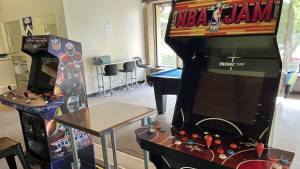When students returned to campus late last month, there were plenty of changes awaiting them. But one in particular seemed to prompt more than its fair share of enthusiasm: the new game room at Gund Commons.
The revitalized space is filled with arcade games, foosball, a ping pong table and two pool tables, one of which used to belong to former President Sean Decatur. There’s a Nintendo Switch that students can borrow and a giant 86-inch TV they can play it on.
For students looking to hang out and let off some steam, it was a great way to level up.
But more than that, the game room represents the latest example of how staff and students are partnering to create a stronger sense of community on campus.
It started last academic year as Student Affairs staff engaged with members of the First-Year Class Committee and interns from the Office of Student Engagement about how to improve the game room. Students surveyed their peers and came back with numerous suggestions: more games, more options, more comfy seating.
The difference has been dramatic — and far-reaching, according to Dean of Students Brian Janssen.
“I go to that building almost every day, and there's always people in there, including sometimes our Mount Vernon Fire Department folks,” he said. “So it is intentionally designed for students, but I think it's nice that some of our other community members are coming in to use it as well. That is kind of the definition of having a community space — anyone can feel welcome in there — and I like that.”
Christiane Betfarhad ’26, who was First-Year Class President last year, said she began suggesting ideas for improvements in January and actively presented ideas to Kenyon staff all semester long. While she didn’t have a direct hand in the redesign, she’s happy with the results.
The additions to the game room have really helped define it as a great communal space on campus for all students, not just first-years, Betfarhad said.
“It was heartwarming to see so many people use that space — using it as an alternative to going out on the weekends,” she said. “I think they’ve really established what the parameters of that space is. Now that we have arcade games, pool tables, ping pong … it’s very clearly a social area.”
That’s not the only instance of changes resulting directly from student input.
The First-Year Class Committee also brought up how students were looking for updates to first-year residence hall lounges. That led to fresh paint jobs, new furniture and physical spaces that are more welcoming — making it easier to build community, Janssen said.
Upcoming projects aim to continue that trend. Consider Colburn Hall, which is finishing a makeover as a student event space at the same time as Bexley Hall next door approaches the final stages of its renovation into student housing.
“It’s a really exciting addition for our student organizations and our campus life,” Janssen said. “It's beautiful on the inside. When they finally unveil it, I think people will be very impressed with how it has transformed from what it was before.”
The furniture that will fill Colburn as well as other elements of the redesign all were selected with student use in mind, he said.
“The intentionality piece is really important,” he said. “How can we intentionally either design new spaces or recreate spaces with our students' needs in mind. As our campus evolves, we will look to that one as a model.”
Joint processes that bring students into the fold could be a game changer as social spaces on campus evolve, according to Janssen.
“I anticipate we'll be reaching out to the campus community for perspective about where students would like to see new things, what they would like to see there, and are there things that we just haven't even considered yet,” he said.
